|
FAQs about Sea Fans
2
Related Articles: Sea
Fans,
Related FAQs: Sea
Fans 1, Sea Fan
Identification, Sea Fan
Behavior, Sea Fan Selection,
Sea Fan Compatibility, Sea Fan Systems, Sea Fan Feeding, Sea Fan Disease, Sea Fan Reproduction,
|
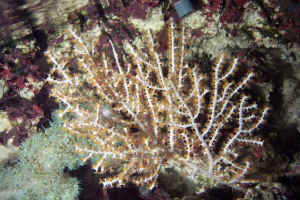
|
Diodogorgia nodulifera preferred foods
2/20/19
Hello crew! Hope this finds you well!
<And you Joanne>
I do have a question but also wanted to share some information about my
Diodogorgia nodulifera that will hopefully be helpful.
<Ah, good>
So, a few weeks ago I got a Diodogorgia frag as a "bonus" with an online
purchase.
<Ugh; I really wish some folks in the trade wouldn't do this>
I know that they are not photosynthetic, but I have had a lot of success
with various photosynthetic gorgonians so I felt I was up to the
challenge.
<Ahh!>
I placed it in an appropriate spot - good amount of water flow, not too
much light - and proceeded to attempt to feed it.
<Good>
Well, over the next few days I tried various filter feeding mixtures,
slurries, etc. and failed to get any feeding response whatsoever, even
though the gorgonian had all polyps extended. This was really starting
to worry me, but then I noticed that the gorgonian was snagging food
every time I fed the fishes! It turns out that the issue was food size,
i.e. it was ignoring tiny sizes but going for the larger pieces.
<Yes>
It will grab and eat bits of food up to about the size you would feed,
say, adult White Cloud Mountain minnows! It seems to do especially well
with flake food, as it is light and blows around the tank really well,
giving it multiple opportunities to feed. There seems to be an upper
limit on the size of pieces of solid food it can grab and ingest, but I
have seen it eat surprisingly large pieces of flake food. If an
especially large flake blows into the gorgonian, several polyps will
grab hold of it and gnaw on it until it (usually) blows away again.
Smaller flakes of approximately 1-5 mm it will just grab and swallow.
I feed the fish twice a day. Now that I know how it likes to feed, I
make sure there are some food particles that are the appropriate size
for the Diodogorgia. I estimate that about 25-30% of the polyps manage
to feed every time the fish are fed. Additionally, I have some Ricordeas
in the tank that are target fed a few times weekly with Calanus or
similar foods, so when I do that now I also give a squirt to the
Diodogorgia.
It looks well and healthy so far, time will tell. So, for my questions -
does EVERY polyp need to grab food, or is the food shared over the
colony?
<They share. Gorgonians are "rindkorallen"; have connected circulation>
I'm guessing the latter as there is that shared rind / skin covering the
animal but I'm not 100% sure on that.
<Oh; yes>
Second question, does this amount of food sound appropriate?
<Yes>
Like I said it looks healthy, polyps extended, no bad/decaying spots,
etc. but have not had it long enough to know for sure.
Thanks again for your advice, and I hope my story may be helpful to
others.
*Joanne White*
<Indeed; thank you for sharing. Bob Fenner>
Diodogorgia nodulifera advice
11/10/16
Hi Bob & Crew,
<Hey Nick>
You have been very helpful in the past so I was hoping you could once again
assist me with some advice.
<Let's see if we/I have some>
I have recently inherited a couple of what I believe to be D. nodulifera (one
red / one yellow) from a friends tank whose bicolor angel had developed a taste
for them. Within 24hours the yellow had around 60% of its polyps extended so I
have been target feeding with Vitalis soft coral food (micronised flake) but the
red has some tissue loss at the base and the tip
of one of the branches and has not extended any polyps as yet, from reading WWM
and anything else I can find it sounds as though this one may be a goner?
<Maybe; but I hate to give up... what have you tried so far? Additions of simple
sugar/s? Overdosing of iodide-ate?>
If you have any advice as to actions for saving it or indeed at what point I
should cut my losses and remove it I would be very grateful. (have read
conflicting reports of them releasing toxins when they die).
<More pollution than toxins w/ this genus>
I have placed them both in the most shaded areas I can find that still receive a
moderate amount of flow.
They have been in my friends tank for over a month and he was sold them with the
advice that they would need to be fed twice a week on soft coral food.
<Mmm; I'd feed more frequently... and/or have a VERY large and vigorous
refugium>
I have been reading up as much as possible on their husbandry requirements and
it seems there are many different opinions on feeding regimes varying from twice
per week up to continuously! (the gold standard I'm sure but not
achievable in my setup). I am planning to make my own food based on a recipe I
saw on the GARF website consisting of mysis/brine, flake, SeaChem ReefPlus
blended together and target fed. I was hoping that 1 feed per day would be
sufficient with this mix but wanted to get your expert opinion on regime and
recipe/alternative foods?
<I would definitely try the DIY recipe you list; and feed at least for minutes
every other day... WHEN polyps are open>
Seems like this is one of those species best left in the ocean for those without
an AZoo tank and I don't usually add anything to my tank without researching
first but given they were angel food otherwise thought it best to try and give
them a chance. Tank param.s listed below.
Thanks in advance
Nick
Tank param.s - 48"x18"x24" w/20g sump/fuge - Temp 25-26 C/ pH 8.1 / Ammo 0 /
Nitri 0 / Nitrate <5 / Phos undetectable / Calc 440 / KH 8 / Mag 1230
Livestock - various soft corals leathers, xenia, GSP, PS Gorgs / CUC / 2 x
ocellaris clowns
<Please read re the Glucose, I2 mentioned above... and let's re-chat in a day or
two. Bob Fenner>
|
Gorgonian ID 1/30/14
Dear WWM crew,
<Andrei>
I've just purchased a gorgonian about a week ago. I've always wanted one
but everything in the shop seems to be NPS, which I don't fancy. This
one looks photosynthetic and the seller confirmed it is.
It is happy in the tank and fully expanding during the daytime.
<Does look good>
This is my daughter's tank (24x12x12 inch/60x30x30 cm with soft and LPS
corals, with LR and aragonite sand, Tunze 9002 skimmer, Fluval Edge HOB
filter - running Blue Life ClearFXPro, Hydor Koralia powerheads of 900
and 1600 lph and MP10 at 40% in lagoon mode, 3x12W TMC AquaRay lights).
The water quality is suitable for LPS, but not for SPS (nitrates 10-15
ppm).
I would like your help in IDing the gorgonian so I can figure out how to
keep it happy in the long run. Please see the attached photos.
At the LFS it was sitting flat unattached. At the moment I've just kept
it the same, with the base in a plastic ring attached to the glass with
a sucker, unsure of how to proceed in attaching it to the rock,
<Best to leave as is for now; the foreseeable future... can/may be
attached in a few ways weeks down the line>
as there are polyps down to the bottom (there is no surface without
tissue and polyps on it). I've seen that usually it gets attached with
reef putty, but I'm afraid that covering the flesh with putty might
start an infection.
Should I remove part of the tissue at the base and then glue/putty?
<I would not do this; no>
Kind regards,
Andrei (big fan and avid reader of the salty section of WWM)
<My best guess is that this is some member of the genus
Pseudopterygorgia; possibly P. elisabethae.
Bob Fenner>
|
.jpg)
.jpg)
.jpg)
.jpg)
.jpg) |
Re: Gorgonian ID
1/30/14
Hi Bob,
<Dr. A.>
Thanks for the quick reply. Before asking, comparing with Google images and
your website my best match was Pseudoplexaura. My gorgonian
branches like a tree, not like a feather. When the polyps are retracted, the
branch gets thinner and the place were the polyp is looks like a hole.
<Ahh>
Flow wise, it is now placed in a gentle flow area in the tank (all the
powerheads are on the opposite side of the tank). Should I expose it to more
flow?
<Not for now; no>
Would it be an option to place a transparent acrylic pipe in a hole in the
rock work and to fit the bottom branch in it without any gluing?
<Yes; or even to simply position rock with a gap amongst to fit the base
into>
One more observation, I've noticed it capturing Mysis and even pieces of
krill.
<Interesting. Do please see the FAQs sections on WWM re Poriferans in
captivity... re issues as feeding, systems.>
Kind regards,
Andrei
<And you, B>
|
Re: Gorgonian ID 2/23/14
Good morning to everybody in the WWM team,
I thought it would be nice to come with a follow up. My gorgonian has
been continuously happy, with good polyp extension and growth.
<Ah good...>
As I don't feed plankton, I assume it is photosynthetic after all.
<I would try... see the second query here:
http://www.wetwebmedia.com/gorgfdgfaqs.htm
The only problem is that it is still not attached. I've placed it in a
PVC pipe with lots of cuts in it and let it be. My wife is not happy
with it being attached with a suction cup to the glass.
<Try anchoring it then... gingerly place amongst supporting rock... or
use a bit of methacrylate to attach it>
It seems to be very resistant and I had the chance to speak with the LFS
I've purchased it from. Their experience with it is that it tolerates
well fragging, it's a fast grower and that they attach it to the rock
with superglue gel, within one week encrusting over the rock (I've seen
this in their display tank).
I know that the LFS water is pristine and probably the likelihood of a
bacterial infection is lower in a large tank than in my nano. So is this
the best way to attach my gorgonian or is there any other recommended
way?
<As above>
Please see a recent photo of my gorgonian. As a note, I live in UK. I
assume the gorgonian's origin is Caribbean/Florida, as I've
recently seen a movie on YouTube with a Goliath Grouper swimming through
vast areas of identical gorgonians that was filmed in West Palm Beach,
Florida (https://www.youtube.com/watch?v=eK3mzjuk91Y ).
<I do concur: Pseudoplexaura sp. likely>
Kind regards,
Andrei
<And you, BobF>
|
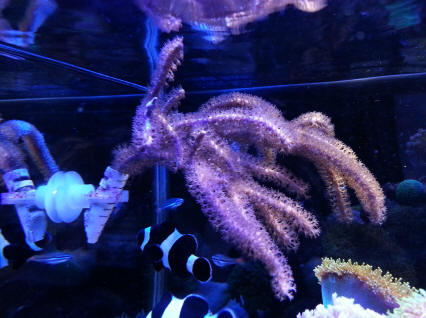 |
|
|
"Leptogorgia sp" 10/14/13
Hey Crew!
I have been at WetWeb for some time this morning, and cannot find info
on this species; "Leptogorgia sp" I bought one 4 days ago and have
followed the sites "directions" but it remains closed. Can you provide
me with a link ?
Thanks!
Pam
<Mmm, had to search the WWM site myself:
http://www.wetwebmedia.com/gorgsysfaqs.htm?h=Leptogorgia+sp
Don't know much re the genus, its care/use in captivity. What little I
gleaned from a cursory review of the Net shows it doesn't typically do
(as) well; even amongst the not-so suitable gorgonians period. Bob
Fenner>
Re: "Leptogorgia sp 10/14/13
Although I was aware that this particular coral requires target feedings
and specialized care (strong flow / low light)
I prepared for the challenge.
<Ah good. We had a very nice write in today re "Blue berry" Gorg.
success.
Look for its posting in the AM>
But, if this coral doesn't even open, there's no way to feed it,
correct?
<Mmm, yes; but you may be able to elicit a feeding response through
introduction of food, liquid from same... from changing the colony's
orientation, amount of current...>
I was wondering why it was so inexpensive ($15.00)!
Thanks Bob, I'll keep trying!
Pam
<Good. B>
Re: Leptogorgia virgulata, hey Bob!
10/19/13
Hey Bob,
Just wanted you to know, that the Leptogorgia virgulata coral is
feeding!
Your advise to blow food in its direction worked!
Within 30 minutes of doing so, it opened up!
Thank you !
Pam Anderson
<Ah, congratulations on your success! B>
|
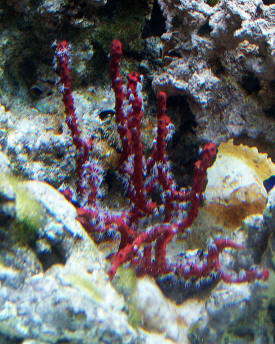 |
|
Cautious Success with Guaiagorgia sp.
10/14/13
Good Afternoon Crew,
<Steve>
Thanks for all you do. In the last 7 years I have grown in skill
and understanding through WWM and would like to share some success with
a Blueberry Gorgonian.
<Ahh!>
The specimen I purchased from the LFS here in San Diego was a vibrant,
healthy looking specimen in a typical sea fan spread. The polyps were
open at the store, and have been regularly here in my 75 gallon square
tank the past three months.
The Gorg is placed mid-way down in my tank (30"x30"x18") about 16"
on center form a Vortech MP40 running at 35% on "Tidal Swell". I
have two MP40s on the back, each running at relatively low volume and
anti-syncing.
The "Lagoon" program is used overnight.
In looking at the morphology of my specimen it was obvious that most of
the polyps faced one direction, perpendicular to the fan. Based on the
limited success of many reef keepers I decided NOT to follow the norm
and pointed the polyps away from direction of water flow. I think this
is a key element in my success.
<I agree>
All new growth to date (estimated 15%), both on the tips of the branches
and on the "truck" near the base, have been away from the current. It
seems to follow that although this specimen requires a brisk current to
keep the branches free of debris, the mouths generally can only catch
food in the more tranquil direction. If the specimen is oriented
"backwards" from the start, feeding may be impossible.
The polyps are always open in the evenings... and most days, but can be
enticed easily if closed with a small amount of Cyclop-eeze in the
water.
Currently I am feeding Hikura Daphnia w/ Cyclop-eeze w/ H20 Life Marine
Fusion. The new polyps are very, very small, so the "shotgun" approach
to different feed sizes are an attempt to satisfy all, It appears to be
working.
This is a mature tank, with ample copepod production to satisfy two
Mandarins without supplemental feeding. I believe this fact plays an
important role as well, especially for the smallest polyps.
<I concur here as well>
During feeding, I slow the Vortechs to 15% on Reef Crest. This is just
enough to keep water moving randomly and let the "missed" food
recirculate.
I use a large baster to target feed, but only trickle the food out and
gently push it through the fan. In my experience these polyps will close
up at from direct "blasts". This is easy to see when you use an empty
baster.
I practiced feeding "empty" a few times to see how much flow the polyps
could handle and still grab the food. It is not much!
I feed twice a day, religiously.
I hope these notes further the cause. I am "tech heavy" so an equipment
list and parameters follow...
Steve
Equipment/Parameters:
30"x30"x18" tank
24 gallon refugium /Chaeto (reverse lighting cycle)
3" DSB (med grain)
110lbs live rock
Apex Controller
pH x 2, ORP, Temp x 2, probes
Dual Ecoxotic Canons
Karollin 1502 Calcium Reactor
Overnight Kalk drip (to counteract the CO2).
Precision Marine Skimmer (runs 24/7)
ATO
Temp: 76.9 - 77.5
pH: 8.00 - 8.18
SG: 1.026
ORP: 310 - 330 (day/night)
Nitrates: 0
Calcium: 420ppm
Magnesium: 1260ppm
Alk/DKH: 9.3
Lights: 12hrs (inclusive of 150 min ramp time at each end)
Lunar: Apex module
<Thank you for sharing! Bob Fenner>
Re: Cautious Success with Guaiagorgia sp. 11/8/2013
Good afternoon Crew... after an additional month of observations an
update on my Blueberry Gorg.
<Hey Steve>
As other reef keepers have experienced over time, my polyps started to
extend less often, and for shorter duration. Water parameters have
remained consistent, as well as feeding frequency and variety. So I
started examining the effects of light intensity,
My first observation was that the polyps that were furthest from my
light source (dual Ecoxotic canons) seemed to open sooner and longer
that the polyps closer to the light source. Knowing that this species
comes from a range down to about 75 feet or so, and often on sloped
reefs, I decided to shield the Gorg to create an imbalance in the
lighting, skewing it towards
the 460nm range.
Initially, I put a third of the specimen in complete shade with two
thirds exposed to the 460nm cannon (I blocked the10,000k). This initial
step yielded an immediate improvement. After a week, the third that
resided in total shade started to open regularly but not with the same
vigor as the 460nm portion which was back to "normal". I have since
placed the entire Gorg under the 460nm (again, no 10k) and the growth
and polyp extension has resumed. Polyps are now open appx. 20 hours per
day.
So in sum, here are my novice observations;
- Have a mature, copepod producing tank.
- Place is a diffused, moderately strong, random current.
- Face the polyps away from the primary direction of flow.
- Effect reversing tidal flow if possible.
- Feed a large variety of food sizes.
- Let the food float into the polyps, don't blast with a pipette.
- Beware of even moderate, 10k+ lighting sources.
I feel fortunate that my light sources are so narrow, it makes the
shielding fairly simple. I can see how in standard lighting systems with
48" T5s let's say, it would be difficult to create the right conditions.
<Yes; I would insert my usual statement here that most systems
are overlit, too intense and too long duration; compared with naturally
occurring parameters>
Often I've read how keeper's Gorgs stop opening and a quest for a "more
enticing" food ensues. What I believe now is that the deterioration is
due to the physical environment, and the Gorg's inability to adapt to
typical tank lighting. More light... more stress...no polyp extension...
no food...and the death spiral starts.
Temp: 76.9 - 77.5
pH: 8.00 - 8.18
SG: 1.026
ORP: 310 - 330 (day/night)
Nitrates: 0
Calcium: 420ppm
Magnesium: 1260ppm
Alk/DKH: 9.3
Lights: 12hrs (inclusive of 150 min ramp time at each end)
Lunar: Apex module
Happy reefing!
Steve
<I thank you again for sharing. Will update/addend your prev. post. Bob
Fenner>
Re: Cautious Success with Guaiagorgia sp. 12/26/13
UPDATE:
Closing in on 6 months with the Blueberry Gorg and we are thriving here
in Southern California!
<Great news!>
This winter's calendar included a two week trip out of the country and
my "fish tender" failed me at the last minute. So the Gorg (and other
species) had to survive on just a couple of frozen food cubes every few
days provided by my brother.
With no target feeding and a lack of personal attention, I resigned
myself finding a decaying Gorg upon return... Ugh. Happily, although
initially a bit unhappy with semi-closed polyps, the Gorg began to open
as usual within 24 hours and feeding/growth continues.
The more I observe this species the more I'm convinced that failure to
maintain health is due to the physical parameters of their environment
and the maturity of the tank. Now that the lighting and current is
dialed in, I am only target feeding a few days a week using ova, Coral
Fusion and Cyclop-eeze. There are some sections of the fan that receive
no target feeding at all (blocked pipette access) and they continue to
thrive.
So my recommendation continues to be for those with Blueberry
issues... stop focusing solely on the types of food. Reduce your
lighting, create moderate random flow, and regular (daily not required)
target feedings. A mature tank is a must!
Happy Reefing!
Steve
<Thank you Steve. Bob Fenner>
Ongoing Blueberry Gorg Success - Update
2/21/14
Good Evening Bob,
<Steve... your files... are an order of magnitude too large for our mail
server. Please>
Things continue to go well here in San Diego!
<Ah yes... I live in Mira Mesa>
Thought I would share a couple of pictures about 8 months along. I
estimate about 25% growth at this point, approximately 7" in diameter.
[image: Inline image 1]
These types of polyps, with the longer tentacles, typically form in high
flow areas...
[image: Inline image 2]
Thanks again for helping us with this truly fascinating hobby!
Steve
<Thank you for sharing.... just smaller pic files going forward! BobF>
|
.jpg)
.jpg)
Appears to be a Hydrozoan at the yellow pointer |
Sharing a Yellow Finger Gorgonian Success
Story 1/27/12
Hello Bob and Crew,
Instead of asking a question this time, I wanted to share a success
story.
<Yay!>
My husband has a Yellow Finger Gorgonian at the center of his display
tank.
When we first received it, it was a beautiful bright yellow with
the red dots and white polyps. We didn't see the polyps come out
much, but we were feeding the tank daily and some would slowly but
sporadically come out.
Then it started to turn brown very quickly. The polyps stopped coming
out.
I knew they needed to be fed often, but somehow missed in my initial
readings that each polyp needs to be target fed a variety of foods. So,
I got a dropper and began target feeding daily with either
Roti-Feast or Oyster Feast. At first there was only one
polyp out on one of the tips and the majority of the Gorgonian had
turned shrively and brown. I knew from what I had read that the chances
of it living at this point were slim, but I was not going to give up. I
target fed the one polyp as well as the other polyps that were
retracted. I'm not too concerned about water quality as we use
AquaC EV-180 skimmers in our tanks that do an amazing job as well as
lots of corals, pods, a starfish and filter feeders who all benefit
from this target feeding as well. Anyway, the next day I dropped some
drops of phyto plankton in and waited 10 minutes as this is what I do
to signal the Sun Corals(Tubastrea sp.) in my tank that it's
feeding time. To my delight there were about 5 polyps out at this
point. I target fed them and the rest of the gorgonian as well. I
followed this procedure on a daily basis for several weeks and now the
Gorgonian doesn't even need to have the Phyto-Plankton drops to
open although I do add it to the daily cocktail. By the time the
moonlights come on, she knows it's feeding time, and very quickly
becomes entirely covered with huge white wide spread polyps waiting to
be fed each day. During the daylight cycle, there are polyps out as
well, but nothing like when it's close to feeding time. I mix up
the daily cocktail sometimes putting flake in it as well, I drop some
Selcon drops in the cocktail as well. The Gorgonian began regaining
it's yellow color from the base up, and is now once again a bright
yellow with the red dots all the way through to the tips with the tips
not completely recovered just yet but getting there. I am so happy I
took the time to nurse this poor starving beauty back to it's
magnificent self, and I urge others to do the same and hang in there. I
feel very bad about my mis-step but feel a great comfort knowing
I've saved it. I hope anyone else in this position has the same
luck.
Jenny
<Ahh, thank you for sharing. BobF>
|
"Purple fuzzy sea fan" question
11/10/08 Hello, <Hello, Jessy here> I purchased a
new sea fan a couple days ago and I have a few questions about
it. I am pretty sure it is non-photo synthetic but maybe you
could verify that for me. I have attached pictures. I have been
searching the internet for a positive identification but I can
not find anything like it. It has pale yellow skin with a
deep purple colored polyp. I have a photosynthetic Caribbean
gorgonian and a non-photosynthetic yellow finger gorgonian and
they are doing well. <Great choices. They are the easiest
gorgonians to care for> They eat Cyclop-eeze and rotifers and
even the small piece of mysis. My new sea fan has much smaller
polyps then the other two. According to the store where I
purchases the feed it phyto every once in a while but I have read
many places sea fans do not eat phyto. <Advice like that from
stores makes me very very angry. Gorgs cannot live on phyto.>
They said they have had it for a while and it was fully open and
healthy looking. I tried feeding it rotifers, Cyclop-eeze and
crushed flake food. It appears to have eaten this but some of the
larger pieces it lets go. It did not eat as aggressively as my
other two. Do you have any suggestions for feeding or thoughts on
the phyto? <Its a great supplement for all kinds of corals,
including gorgonians, but in no way is it enough to sustain this
species.> I find Sea fans and gorgonians amazing and want to
get as many as I can in my reef. <I agree, I love Gorgs as
well and have kept many in my tanks. This species is not very
hardy in a captive system. I fear you may only be able to keep
this specimen for a time (months maybe) before it succumbs to
starvation. You are doing well by feeding multiple foods,
you can try adding a few of these foods I've had success
with. Prawn eggs (great for your yellow finger Gorg), Oyster Eggs
(Reef Nutrition has a great new product, Oyster Feast), Coral
Frenzy, and crushed flake foods. You should be target feeding and
making sure they get a good variety of food. Please if you get
more Gorgs, stay away from the non-photosynthetic kind unless you
have a dedicated system and are well versed in the care for these
animals. And for the record, never get a blueberry gorgonian.
They won't live even with the special feeding I've given
them. A good reference for types of Gorgs that are proven to
survive in captivity http://www.garf.org/GORG03/WINTERGORG.html
This piece is beautiful and I want it to thrive. As always thanks
for all your help and sharing you experience in this matter.
<Good luck. I don't want to sound all doom and gloom, but
you will find that the smaller the polyps the less chance you
have at keeping the Gorg long term.> Kind Regards,
Jeff
<Regards, Jessy>
|
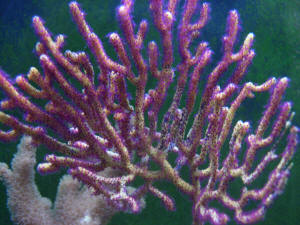 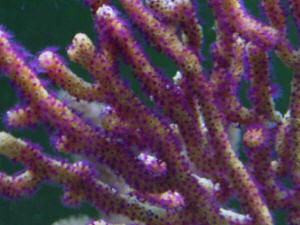 |
Dried Bahama sea fan flaking off
in aquarium, is this toxic? 2/17/06 Hi guys,
<And some of the tender gender> I need to know if the flaking off
of the dried Bahama sea fan is toxic to a reef tank? <Don't
think so... at least "not very"... Have used, seen these used
over the seemingly eons I've been involved in our avocation> The
fan has been removed, but it has created a mess, my mistake! Thanks so
much, Mike <Think "this too shall pass"... or be
collected, removed in time. Bob Fenner>
Sea Whips - Not for the Aquarium,
She Wants Dead Ones I have an odd question. Do you know where I can
purchase a few sea whips. Preferably dried and flat for framing.
<Try a dried flower shop/craft shop. James (Salty Dog)>
Gorgonian Identification
Hi, <Hi Kevin, MacL here with you today.> You seem to know a
lot about gorgonians, so I was wondering what type this is, it came
on a purple gorgonian that I bought. <Without the polyps being
extended its very hard to tell Kevin. Can you get an additional
picture with them out?> How much do you thing this little frag
would go for? <That's a tough question because price
fluctuates depending on the area.> thank you,
Kevin |
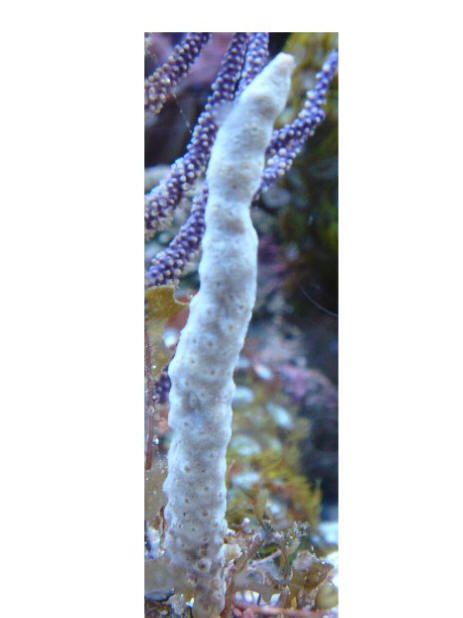 |
Feeding Diodogorgia - 4/14/05
Hey Guys. <Hi. Paul helping out today> I need some
help. <What we do here.> I got a Yellow Finger
Gorgonian Coral a few days back, and I need some help feeding it.
<OK> I saw on GARF.org the following instructions
<You could always call GARF. They are quite helpful Support
(208)344-6163> INGREDIENTS: Flake fish food - 1
tablespoon SeaChem Reef Plus - 4 tablespoons Fresh water - 1/4 cup Soak
the flake food in the Reef Plus for one hour and then add the fresh
water. Puree the mixture in a blender for several minutes. After you
allow the mixture to set for several minutes you can pour the smallest
particles off with the water. The larger particles will settle to the
bottom of the glass and they can be used to feed the Gorgonians. I
have no idea as to how to actually "feed" the coral.
<I would use a syringe (without the needle, of course) or a small
turkey baster or baby
snot ball, and suck up a small amount of food and actually
squirt around the extended polyps. Try with flow (pumps and skimmers)
off first for 5-10 minutes then turn them on. I would feed once every
three days or so.> Do I feed it inside the tank?
<Absolutely> Remove it? <If it is easy you could
but I would not> I do not know. Any help would be
appreciated. <Hopefully I have helped. Please do take this
opportunity to learn from this situation, and be sure to do as much
research as you possible can before purchasing to save your bank
account and yourself extra effort. Thanks for being part of it all.
~Paul>
Gorgonian in aquaria
- 2/10/05 Greetings Bob & Crew! <Greetings from sunny
N. Cali> I have a question on coral compatibility.....rather is a
coral compatible with my system. <OK> My girlfriend
bought me a coral for my birthday. Luckily she had it held at the LFS
until I am able to get the QT tank setup.
<Well.....encouraging to hear> Anyway, she bought me a yellow
Finger Gorgonian (Diodogorgia nodulifera??). I have a 55-gal reef
that is thriving. It has a large space near the back with no corals,
inverts, or anything staking out territory (except for my yellowtail
damsel who thinks she owns the tank). It is a relatively high current
area, which is why no corals are there. All other areas are occupied by
corals or my anemone (hasn't moved in a year) so this location
would be good from the standpoint of not coming near any other
corals. <Well, let's look at the needs of the coral first
The finger coral comes in two colors, bright orange yellow with red
calyces and white polyps and the other is red with darker red calyces
and white polyps. Finger corals are rather brittle and will break. They
usually only grow to about 25 cm (10 inches). They are not
photosynthetic.> Lighting - Water flow: These corals are
usually found in water deeper than 25 meters (75 feet) on hard-bottom
in the Caribbean. They are attached to the bottom in strong current.
Difficulty of Care: They need shade or indirect lighting with a
strong current. They need to be fed at least once a week or they will
starve. There is a lot of information on this coral on the web and in
books. Usually can be kept successfully in captive aquaria.> My
concern is lighting. This area is almost directly under one of my 175w,
20,000K MH pendants. From what I have researched, these corals are not
photosynthetic. <Correct> I have read conflicting
info regarding where they can live. Some say intense lighting is of no
concern, others say that they cannot live under MH. <I would
be more worried about feeding and flow. Do some research (GARF.org
seems to propagate these corals regularly and seem to have great
success with keeping them> I do have one other area that could fit
this coral (with room to grow) in a back corner. The problem is that
this spot has a relatively low current flow. <Be more concerned with
flow and feeding rather than lighting. Maybe you can place something
above it to diffuse the light. Maybe a green Nephthea frag or
something.> Can I house this coral in my system? <I
don't see why you couldn't. Flow and feeding are the most
important aspects to be concerned with (which I have stated several
times here already....I know)> Do you have any advice on doing
so/not doing so? <I would go for it> Sorry, I guess this
was not as quick of a question as I thought. Thanks for your
help. <Thanks for being part of it all
~Paul>
| Coral ID. Hi all, just have a quick ID
question. The LFS sold this rock to me as "live rock"
(sorry about the picture quality). <Not too bad, good
enough.> I know it's not that, but I'm having a hard
time pinning it down. It has pink, leathery skin and tan polyps
that are about 3/8 inch high with 8 "fingers". The polyps
retract at night and the skin becomes shiny. It is spreading to the
other rock that it comes into contact with. <Yes, very
prolific.> It's probably common but I haven't had any
luck on the ID. Thanks for any help you can provide. ~Danny B. in
Blanco, Texas <Well Danny, what you have there is likely
Erythropodium, possibly Briareum, but my bet is on the former. It
is a very fast spreader and rather noxious. -Steven Pro> |
|
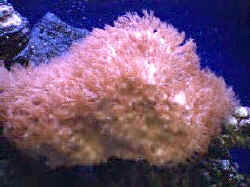
|
| Help
with coral ID Hola Robert :) <Hola, Edgar... Anthony Calfo
in your service.. a fellow reefer, and reef author> Edgar From
Mexico again :) hope the troubles with the page can be solved soon,
I was really scared of thinking the page was gone. Now to business.
I wonder if you could help me to identify a soft coral I have. Is
an octocoral and I think is Clavularia sp, but some of my friends
say might be anthelia or even Xenia (which, if its true, will make
me happy :) ) the polyps are small (1 inch height), the arms
(pinnules? are "branched". its color is light brown. and
they close at night and retract the arms, leaving only a
"bump". I have to pictures which I could send you if you
like. thanks edg <please do send a pic, I suspect that it can be
ID'ed quickly with a reasonably good photo. With kind regards,
Anthony> |
Re: Help with coral ID Anthony, Here are two
pictures of how much the polyps have grown in 6 mo. picture 001 the
lower mass is the newest, the piece up (center) is the original. it
grows onto the rear tank glass (picture 002) some where around
10"+ in diameter. This is where I cut from and glued it onto
other rocks. Can you tell what kind it is? As soon as I get a good
tank picture I'll send it. Anthony, <Absolutely... nice
picture too, thank you. It is Erythropodium...AKA "encrusting
Gorgonian". a hardy and fast growing animal that is similar to
Briareum from the Pacific but is distinguished by its smooth mat of
fused stolons and usual brown/gray color (Briareum stolons are
purple, calyces are raised). A little caution here as Erythropodium
actively seeks some other corals to encrust upon and kill. But
indeed fast growing and fun>
<Looking forward to it! Kindly, Anthony> |
 |
 |
Orange Tree Gorgonian vs. Algae 1/5/05 Hi,
purchased a Orange Tree Gorgonian for a 12g. NanoCube set-up almost two
weeks ago. <Sorry to hear that. These animals have
terrible survival records in captivity.> I went out of town for a
week for the holidays and upon return found my glass, rocks, substrate,
and the gorgonian (not as much) covered in what I think is
Cyanobacteria (slime to 'hairy' appearance and a dark red to
brown color). I did a 40% water change and removed some of
the slime covered substrate and replaced with some live aragonite sand
and cleaned the sides of the tank. I might mention I believe
the bacteria/algae outbreak was due to overfeeding the system before I
left. <Overfeeding certainly can contribute to algae or
Cyano blooms. Maintaining pH and Alkalinity on the high end
will help prevent/combat these issues.> Anywho, the gorgonian I was
wary to interfere with too much. After reading some of your
articles/forums I decided to take a chance to brush away some of the
algae/bacteria with one of my watercolor brushes and it worked to a
degree. Also, the tips of three of the six branches are
wearing thin, as in skeleton is all that remains. I feed it
once every-other day with Marine Live Phytoplankton and roughly 60% of
the polyps come out regularly, even those near the decaying tips.
<Unfortunately, phytoplankton is probably not a suitable food for
this animal (too small). Tiny zooplankton is probably more
appropriate. Some of these animals can be very specific in
what they will capture. Sometime Artemia nauplii will be
captured, but you must observe that they are captured AND ingested.>
I moved the gorgonian to be more in path with the one powerhead outlet
in the tank so as all the branches are getting water flow. <These
animals do appreciate a lot of flow, but those that grow in a flat
"fan" are generally used to gentle sweeping and waving
currents, not the blast of a powerhead. Reproducing this
kind of water movement is difficult even in very large aquaria with
surge devices.> I read that it is sometimes wise to amputate the
gorgonian to prevent any further decay. Any thoughts or
ideas as to the prevent further decay. <I would snip off
any branch tips that are fouled with algae. This may slow
the loss of tissue.> One last thing, I know that these corals are
not the easiest, but I've had one tank going for more than a year
now with no deaths so I thought this NanoCube would be easy, are the
Tree Gorgonians relatively successful in home aquariums or
do most fail? Thank you very much for your help in advance.
-David H. <Photosynthetic gorgonians (usually gray and/or brown) are
very hardy and generally do well in aquaria. Most of the
colorful ones are not photosynthetic and do very
poorly. Their strict requirements for food and water
movement are very difficult to reproduce in captivity. Sorry
to be so negative, but non-photosynthetic gorgonians almost never
survive. Best Regards. AdamC.>
Re: Orange Tree Gorgonian vs. Algae (?) Do you believe it
would be best for me to immediately remove the Gorgonian from the
nanocube, or should I give it time and possible a chance to rejuvenate?
<AdamC is out, so I'm responding in his stead. I would move this
Gorgonian only if you have better circumstances for it elsewhere...
larger, more stable, with more plankton... otherwise it is likely
doomed... Do pay close attention to water quality...> I hate to just
throw away $30 like this but I suppose it is my fault for not looking
further into it. <Yes, if you're asking> I do
have a xenia that was given to me as a Christmas present, I was told it
was a Pulsing Xenia, but I am not so sure it is. Please view
the attached picture. <Umm, please read here: http://www.wetwebmedia.com/xeniidarts.htm and the
Related FAQs (linked, in blue, at top)... Xeniids pulse or not...
depending...> Also, can you recommend any corals that would do well
in a 12 gal. Nanocube? I was considering Colony polyps and
maybe Green Grape Caulerpa or some other macroalgae. Any
suggestions welcome. Thanks again! <... Please read here: http://www.wetwebmedia.com/smmarsysstkgfaqs.htm
and on to... the areas on WWM re coral selection... Bob Fenner>
Re: Orange Tree Gorgonian vs. Algae(?) Ok sorry, one last
question, I hate to abuse all of your time. <No worries.
Not possible> Thanks for helping me get things on the right
track. In regards to the Gorgonia, I do have a 44 gal. Pent.
tank which has been established for one year now. There is
'low' lighting conditions in this tank, it only runs with
two 18", 15watt bulbs (50% 6000K & 50% Actinic 03
Blue). Right now the tank is running with a Penguin
powerhead that pushes 145gph, and I've got roughly 30-40lbs of LR
with some good spots of Coralline going. Would it be better
to move the Gorgonian to this tank? <Yes... on two basic important
counts... one, that it may help it to recover (move underwater, not in
the air... in a bag...), and that if it does continue to slide, die, it
will have vastly more water to do so in> Also, on a completely
different note, I'm considering bolstering my lighting system on my
44gal corner pentagon. The hood that came with the tank is
pretty crummy and only has room for two light fixtures with
18'' bulbs. I was considering buying a glass canopy
for this tank so I could have more flexibility in lighting and not have
it so that it only fits two rectangles 3.75''W x
18.5''L. If I were to get this glass hood, and put a
new PC lighting system on top would I leave space between the glass
hood and the lights, or just press the light system flush with the hood
and leave no space between? <The latter is much better. Bob
Fenner> Thank you very, very much for all your help on these
matters. Sincerely, David H.
Gorgonian ID Key, Stocking Query Dear crew! We
are dealing with the animal husbandry and we've a lot of problems.
Recently we purchased two unidentified gorgon Arians . The first one
forms a bushy red colony with white polyps & thorn-like cups,25 cm
tall. The second one is a tree-like brown colony with blue polyps 15
cm. tall. We assume that they are Muriceopsis flavida & Eunicea
succinea, but we are far from to be sure. Could you send an
identification key? <Mmm, no. Don't have. There are some
in-print reference works (e.g. Alderslade et al.), but no such on-line
source as far as I'm aware> Both they were in the quarantine
about 2 month. Now they are melting, Their polyps are closed, & in
the second species the tips of branches are shrinking. May this be a
melting consequence? <Yes... I proscribe the keeping of just a few
species for the trade, for sale... these are described, listed on
WetWebMedia.com> Could you also inform us about the hydrochemistry,
in particular, Ca, Sr, Mg and the with the other Cnidaria. <Posted
on WWM> P. s. What do your think about the following livestock: 1
Euphyllia glabrescens (diameter (d)=10 cm), 1 Sinularia sp. (25 cm
tall), 3 specimens of Alcyonium sp.(50 cm tall), 1 Galaxea sp. (d=5
cm.), 1 sphaeric colony of Goniopora (d=15 cm), <Am not a fan of the
aquarium use of this genus> 1 colony of Cladiella sp. (25 cm. tall),
4 specimens of Sarcophyton sp.(2x20, 15 & 10 cm),2 specimens of
Lobophyton sp. (25 & 20 cm tall)& 2 colonies of the gorgon
Arians mentioned in 250 gal aquarium (assuming that all the other
factors are normal one)? <Could, can be done, given space between
all. Bob Fenner> Best regards, Interzoo.
Feeding gorgonians and
filter feeders Hello I have just added to my 155 gal tank some
finger corals, gorgonians, mushrooms, some Featherdusters, I have a
plate coral, and some other anemones. All these are from the Atlantic
side of panama in central America. I also have a Atlantic blue tang and
3 snappers. I added this in the past weekend. My polyps 2 of them
don't seem to be very well. What should I be feeding them I was
reading in your book that they filter feed and have to few days a week
give them food. Should I buy those bottles they sell at the stores I
think I saw one from Kent marine called Micro vert that feeds inverts
its liquid style. And zooplankton what should I do? << I think
all types of plankton foods like that are very beneficial to
corals. Live plankton better than bottled plankton, but all
plankton is good. Also, lots of light. >> Thank you
much << Blundell >>
| Gorgonian and mushroom problem 8/10/04 Hi
all, I am having a problem with the gorgonian. Over a
short time, like maybe a couple days, I have noticed some decay of
on of the branches and it seems to be spreading. It started with
sloughing of the skin and then progressed. Images of this
progression are attached for you to see. I don't know what
caused it or how to stop it from spreading except to cut off the
infected branch. We are also thinking of doing a water change.
<I would suggest cutting off the affected branch and discarding
it. Water changes never hurt.> I have seen the emerald green
crab on its branches at night and wonder if it's snacked on
one. Please advise. <Very unlikely. I
suspect the crab was just exploring. There are much more
accessible and tasty things to eat in your tank.> The tank specs
are 45gal, 50lbs LR, aragonite fine grained sand, salinity 1.024,
pH 8.2, ammonia 0, nitrate/nitrite 0, ca 400ppm, 82F. Bioload is
mostly corals: gorgonian, green star polyp, cutting of brown star
polyp, anthelia-type coral Adam says is really Clavularia with
mushroom anemone, candy cane, Zoanthid cluster, mushroom cluster,
single mushroom, and a small coral the LFS said was the poisonous
p. toxica. The only fish is a green spotted false mandarin (s.
picturatus) and looking into setting up a pod refugium for him as
well. A peppermint shrimp (feed him shrimp pellets occasionally as
concerned he might be eating the mandarin's pods, although I
saw him catch and eat a big amphipod in broad daylight!) An emerald
crab and a dark purple crab that stowed away in the LR. So not that
much, just 8 corals, 1 fish, 2 crabs, 1 shrimp, and a bunch of
Turbos. <I am not a fan of crabs in general, but I would look
toward the purple one with particular suspicion.> Regarding the
mushroom, it's foot seems to be stretched from the left. I
thought they divide down the center to reproduce, but could this
also be some form of reproduction or just trying to get a better
grip? Thanks for your advise, Daphne <The mushroom
could be stretching out to bud off a daughter, could be creeping
along the rock, etc, but it looks fine. Do keep an eye
out for daughters to sprout up! Best
Regards. AdamC> |
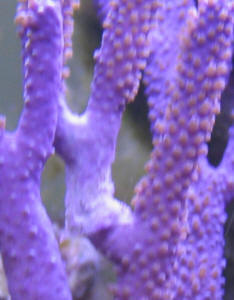 |
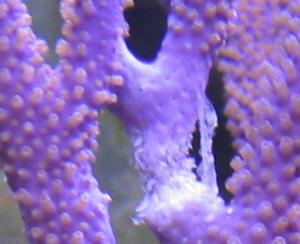 |
Interzoo Odessa - water quality param.s 7/31/04 Dear Anthony
Calfo! This message repeats that was sent in 19 of July, and, perhaps
was missed. <my apologues... it does seem so. I was out of town that
weekend too for a rip/lecture in KY state> We were glad to read your
answer. Let us represent ourselves. We work in aquarium husbandry in
Odessa, Ukraine, and our staff includes experienced hydrobiologists.
Not all literature in English is available here, and e-mail ordering is
too unsure. <sorry to hear of the limited mail-order access> So,
an on-line ID key would be preferable. Could you recommend us any
web-site? <yes... http://www.coralrealm.com/ may be a
good start> By the way, the livestock is supplied by international
wholesalers and is licensed. Nevertheless, frequently it comes without
exact identification. <this is sadly the standard> Our
preliminary ID of at least one gorgonian species was wrong. It is
Calycigorgia sp. instead of Eunicea succinea, the other species
(Muriceopsis flavida (?)) still on question. Nevertheless, we had
success with both them, including their active growth in our aquarium.
<growth spurts are not uncommon with these animals... but they still
suffer from attrition in less than a year or two for most aquarists.
Very rare to get azooxanthellate species to survive one year in aquaria
let alone two> The other deal, is our client. We have described his
livestock. Sorry for misunderstanding, but we meant the species'
compatibility, not their specific needs, assuming that they are
satisfied completely. As we understand, the whole population seems you
normal and not troublesome. In any case, thank you for your help! Let
us ask you some additional question: - What are the basic hydrochemical
requirements of gorgonians, in particular, regarding Ca, Sr, Mg, I?
<there is variation on reefs around the world as to what is
"natural" levels for such parameters... but most tropical
reef cnidarians will tolerate a standardized water quality. Calcium can
be supplemented to a range of 350-435 ppm (avoid excess/higher
levels)... and Mg should be about tripe whatever your Calcium is
(around 1000-1200 ppm is fine). Iodine and Strontium can be replaced
perhaps with regular weekly water exchanges (20% or more of tank
water)> - Could a melting of a given gorgonian cause shrinking of
the branches' tips & prolonged closing of the polyps?
<yes... and it can be contagious to other healthy corals in the
system> - On separate locations of some Calycigorgia branches the
brown film is appeared, and the branches in those places became
thinner. Is it just melting or some abnormal process (infection)?
<it sounds like the aquarium does not have adequate water flow (20X
turnover or more is needed) and some diatom algae has grown onto the
branches and is smothering them> - What's your opinion about the
following parameters: [PO4---], [NO3-], [NH4+] - all them - 0 ppm;
<a small amount of nitrates is needed to feed most cnidarians...
5-10 ppm is fine> [Ca++] = 400 - 420 ppm; <very good> pH = 8,1
- 8,2, <too low... especially if this is a daytime reading (it gets
lower at night). Target 8.4-8.6 for stability> KH = 9o, S. G.
=1,023, t = 82o F <very good> P. s. sorry for our English. Best
regards, Interzoo,
Odessa.
<no worries at all... your English is quite good :) I wish you the
very best of luck, my friend. Anthony>
Are Non Living Red sea
Fans Aquarium safe? 4/28/04 Hello: I recently purchased some Red
sea fans (non living, decorative) to use in my aquarium. I
was told by another person that these cannot be used in the aquarium
because they will fall apart. I was also told that the Red portion of
the Sea fan was the animal. Are these non living sea fans aquarium
safe? Thank you <it depends... if the tissue has been stripped away
and the gorgonian (woody) stem has simply been dyed or painted... then
it may be safe. If there is still dried red tissue on it... then there
will be some rotting. If the sea fan was packaged wrapped in plastic,
then I suspect it was/is safe. Anthony>
Flower Anemone Baby 2/25/04 Cheers Crew, One again, the
website is great and the information has brought peaceful sleep to me
more than once, <Ahhh... good to hear!> but I've got two
quick questions. In my large reef tank I recently brought in
(post quarantine) a purple sea whip and golden sea rod.
<hmmm... I'm content with the purple whip, but wonder/suspect
the golden rod is azooxanthellate (night feeder) and as such, doomed
most likely to starve to death in the next 6 months or so> Mounted
them w/epoxy to small rocks to get above the sand, all polyps are out
and healthy. My question is I have an upstream refugium and
a 6" DSB, is there any thing else that my benefit them food wise
other than the occasional Artemia wash and the chopped krill/seafood
mix I feed to the larger corals? <occasional feedings of
phyto like DTs brand phytoplankton> Also, just noticed a baby flower
anemone--e. crucifier (@3/4" dia.), while feeding my colony of
these anemones, is there anything to do for it besides let it live and
grow. <target feeding will help tremendously> It is
attached just below the far edge of the mother's
disk. It was quite an amazing site to find, I guess I must
be doing something right for the tank, best wishes to all, Joe Bales
<kindly, Anthony>
|
Identification gorgonian 1/10/04 Hello to you WWM Crew
:) At first I want to say sorry for my English; it's not my
native language :). <Hello Petra! No apologies
necessary, your English is outstanding!> Pease can you help me
to identify my gorgonian? I've looked all around the internet
but I can't seem to find what species it is. It has a
bumpy white base, grows treelike and has small light orange
polyps which come out at night. <Hmm... Looks like
Swiftia sp., but Swiftia is generally all bright
red/orange. Perhaps this is an odd morph or
bleached.> (I hope they will come out in the light at sometime
:)) <They may. "teasing" it with food
additions during the day may help in this regard.> I am
feeding it with phytoplankton 3 times a week. At some of the tips
the black skeleton is visible :(. Should I remove these parts or
will the living tissue come back? <Since you are feeding
phytoplankton, I guess you know that this gorgonian is not
photosynthetic. The problem is, phytoplankton may be
an appropriate food, but it may not be. These animals
are very specific in the size and type of prey they will accept,
and meeting those requirements is very hard to do. You
may want to try some other food sources (rotifers, baby brine
shrimp, etc.), but unfortunately I suspect that it will continue
to recede until it dies. You can remove the exposed
skeleton with a sharp scissors, and it may get re-covered by
tissue, but probably not.> Well I hope I haven't asked to
much questions at once, but your website has been very helpful so
far. <Please ask all the questions you want, that is why we
are here! Best regards! Adam> Hoping to
hear from you soon, greetings, Petra
|
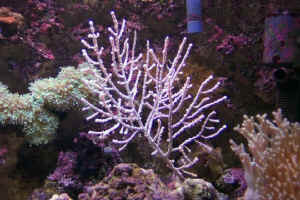 |
 |
Grey Sea Rod 1/4/04 I am finding out that I keep returning to
your site for more and more info. <great to hear...
please tell friends about us too> I just purchased a Grey Sea Rod
and a few others and had them shipped in. When I got the box
the Grey sea Rod bag had busted and the only thing keeping it wet was
paper towel. <Hmmm... actually, moist packing (wet paper
towels/newsprint but no water) is common and appropriate for many
gorgonians. In fact, the mortality of some species during extended
transit if shipped submerged can be quite high> I immediately
floated it and began unwrapping it in my tank. Most of the
coral had disappeared and only the hard center left but there was about
2 - 3 inches left at the bottom so I began to frag which I have never
done. <my yes... does sound like it shipped badly for
water reason; there's no living tissue at all when you get down to
the woody gorgonin stem> Some of the tips of the coral I glued into
slate and placed in a grow tank. Will my mother colony make
it through or is it doomed to die? <I cannot say without
a pic at least my friend. Gorgonians are resilient though> It looks
pretty bad, some of the polyps have opened but most are
gone. On my frags the are splotchy with some polyps
remaining but the purple soft part falling away and revealing the hard
core. I have put calcium and Iodide in the water to try to
help the healing process. Any advice would be
helpful. I am knew to the hobby and need all the help I can
get. Also do you have any advice on re-attaching a piece of
Red Ball sponge to rock. At this time I have it's old
base touching a rock and resting on top of another for support. Thanks,
Jerry <At this point, my friend, the best advice I can give you is
to please research animals thoroughly before buying them. The two
choices mentioned here (Gorgonians and Red Ball sponge) are two of the
absolute worst candidates for survival in any aquarium, and not to be
recommended to beginners under any circumstance. Frankly, I will be
very surprised to hear that the red ball sponge lives to see even 6
months in the aquarium. And if you meant other gorgonians with the grey
sea rod above... I fear that you have taken some aposymbiotic species
(Red, orange or yellow), which have an equally dismal track record in
aquaria. Please do consider Eric Borneman's "Aquarium
Corals" for a very good read and pic reference... or my "Book
of Coral Propagation" for the fundamentals of reef keeping (first
half of Volume one lays this all out... about 200 of 450 pages)... and
of course, Bob Fenner's CMA for outstanding comprehensive marine
keeping info. Best of luck, Anthony Calfo>
Seahorse Compatibility Hello I've got 90g cube tank, and
I want to put in only seahorses and gorgonians. Will they live
together? Best regards, Darek <Well, Darek- it is certainly possible
to put these animals together. The seahorses will probably hitch on to
the gorgonians at some point, which may irritate them, so do keep an
eye on things. I'd also make sure that the gorgonians that you are
contemplating keeping are species with a good track record in
captivity. Good luck! Regards, Scott F.>
Gorgonian Grub Hello Scott, <Hi there!> I brought some
Liquid Life BioPlankton today from my L.F.S. and I started with one
pump for my 45 gallon tank!!! I've read in some web
pages that I should pump every other day, what do you think? It does
not say in the bottle. <I'd tend to agree with that advice;
although I'd make sure that you're keeping up the water quality
in this tank. Do monitor the water chemistry, to assure that everything
is up to par. You certainly don't want to pollute the water. Also,
you may want to check on the net regarding specific applications for
this product. Liquid Life, USA's owner, Ed Ramirez, is a nice guy
who will be able to give you some good pointers on its use. Bon Appétit!
Regards, Scott F.>
Goin' For A Gorgonian! Good afternoon Scott, <Hi
there!> I hope you had a great turkey day!!! <Typical...Ate
w-a-a-y to much...!> Well Scott a got a question for you. I just
brought a yellow gorgonian!! <Sounds nice!> And I was
wondering, I have a bottle of Selcon its that good feed for my
gorgonian, or should I buy some Reef plus instead and feed once a
week??? Thank you <Well, if you're referring to one of the
Diodogorgia species (like D. nodulifera, which is frequently called the
"Yellow Gorgonian" in the hobby, then feeding is very
important. You really want to use plankton-like foods to feed these
animals. Selcon is a great enrichment for many foods, but it is not
really a substitute "food", in my opinion. I'd utilize a
preparation like Liquid Life's "BioPlankton", or Frozen
Cyclop-Eeze. They do require a pretty high level of care, or they will
typically waste away in captivity. Do a little research on the 'net
to verify the species that you have, and then give the animal a lot of
attention, and you may experience some success...Good luck! Regards,
Scott F.>
Encrusting gorgonian care - 11/24/03 Hi, I've had a small
frag of encrusting gorgonian (sp?) in my tank for about 2 months. I
cannot tell for sure if it is growing or not. <Depending on light
and condition of the tank, could be a very fast grower but I have
noticed mine growing slower these days. What a pain though. This stuff
can move rapidly when very happy. Watch carefully. Will cover
everything in its path and in some case will even irritate or sting SPS
once it touches> The polyps usually open for the entire photoperiod.
<Sounds OK to me> I have it on the top of my rockwork, where it
receives current from two opposing power heads, and occasional
turbulence from a small HOB filter. <Sounds like one of my setups.
Indirect current right?> The guy at the LFS didn't really tell
me anything about it's care ( no surprise huh?), <Well, no
surprise but there are plenty of books, sites, and forum help out there
to be educated that one shouldn’t even have to ask about it when
buying. (Except for the water parameters of the source tank)> And I
know it was my responsibility to know the care of an animal before I
purchased it. <That’s right!!!> When I search on the
internet, all I seem to find is information on regular branch gorg.s.
<Don’t get me started. I see many hits when I use my favorite
search engine. C’mon now.> I do weekly water changes, because
I'm not too comfortable dosing anything just yet. <I
wouldn’t dose anything you don’t test for. Save the
money.> I have been feeding DT's in the tank as another source
told me that would be good for it. <Not so sure. I have never
directly fed mine> Do you have the proper name of this creature?
<Well, do searches for it on the internet as there are few variances
of encrusting forms of gorgonian. Some of these so called encrusting
forms could even be misidentified. Check our page: http://www.wetwebmedia.com/seafans.htm>
at least that way my searches could possibly be more fruitful. I really
want my Gorg to thrive, and I hope you, or someone else could help me.
<High lighting and various strong flows seem to help them thrive in
my experience. No need to feed phyto.> It seems as if not too many
people on the boards have these things. <'Cause they are a
menace when they get loose!!! ~Paul>
|
Azooxanthellate gorgonian... another statistic 10/22/03
Greetings from Denver, Anthony, I don't know what's wrong
with this gorgonian. Last month, it looked great (see pic), after
moving to the new system, it looks terrible, with stringy algae
like stuff. It saddens me to watch it die, is there anything I
can do to save it? Looking forward to seeing you in Denver next
month! Thanks, Stormbringer <not much to say mate. They all
"look good" for some weeks... even a few months after
import. And almost all of these non-photosynthetic gorgonians are
dead within 6 months of collection. They should not have been
collected, offered, or purchased IMO. It died like every one
I've every seen has... attrition and giving up the fight to
encroaching algae. We do not know or cannot provide what they eat
(nanoplankton and smaller in some cases). Bottles phyto foods
with at least some species (this one I believe) are a joke.
Yikes... sorry to be so grim, but it is what it is. The red,
orange and yellow sea fans are well-deserving of their reputation
in captivity. My advice is to never buy another unless you can
set up a species tank for it. On a better note... I am very eager
to see you and meet the Denver gang next month! Sure to be a
great time. Anthony>
|
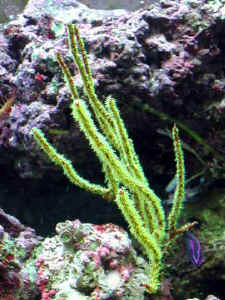 |
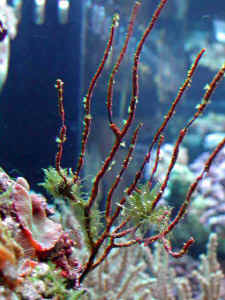 |
Blue polyp gorgonian (Azooxanthellate species) 10/20/03 I
have a blue polyp gorgonian (Acalycigorgia sp.). I have been feeding
the same food that I my Tubastrea. Its Cyclop-Eeze and it seems to be
really helping my animals. <it is a fine food> I was feeding
Selcon soaked Mysis until about 2 months ago when I heard of
Cyclop-Eeze. <the Selcon is tremendously nutritious... please
resume> I do not have a refugium. I do know that a refugium will
greatly increase the health of my gorgonian. <more than you know, my
friend> Hopefully soon I will be using one. My question is will this
gorgonian have a problem if it is lifted out of the water? <why
bother... do play it safe and bag and move under water if it needs to
be moved> It has grown a couple of inches in height and when I do a
water change it is getting too close to being exposed to air? Can this
gorgonian tolerate air or will it die if exposed? <Hmmm... I'm
not completely certain. I suspect it will be fine. But is may be a good
excuse to propagate it (cut off the growing tip and superglue into a
hole in another rock). Best regards, Anthony>
Blue polyp gorgonian care 10/21/03 Hi Anthony, <cheers, my
friend> Thanks for answering my questions about my blue polyp
gorgonian ( Acalycigorgia ). I do have a couple of remaining questions
if you would be so kind. <my/our pleasure> Would the Selcon
soaked Mysis be a better food than the Cyclop-Eeze? Would you
alternate? <Selcon is a very good supplement all ways around
(fishes, corals, anemones, etc) - please continue to use here. But as
nutritious as mysids are for many animals, I suspect they are way too
large for gorgonian polyps here. Better for larger polyped animals and
many fishes. Continue with Cyclop-Eeze> When I frag it can I use any
old superglue that I get at the hardware store, or is there a marine
type of superglue? <DIY superglue is fine... just be sure to use the
thick gel for ease of application> When I add the refugium on this
tank, will there still be a need for a plankton reactor? <that
depends on the style of fuge you set up and how strict you are about
keeping it safe from plankton predators (no shrimps, crabs, fishes,
corals, etc in it)> Will the zooplankton population in the fuge, and
my daily feedings be enough for this gorgonian to thrive? <quite
possibly... install as large a refugium as possible: 20-40% the display
size of you can> Thanks again for your help. There are a countless
number of fish and corals that are still living because of WWM.
Peace
|
|

